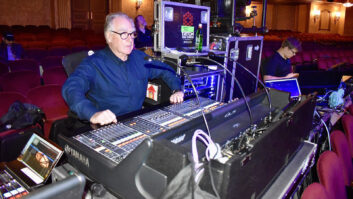(l-r) Frank A. Montano, Scott Hecker, Chris Jenkins and Tyler Bates.
Photo: Gary KruegerBy Mel Lambert | content-creators.com

Los Angeles, CA–Following its recent seminar spotlighting sound design for Star Trek, Motion Picture Sound Editors/MPSE attracted a standing room-only audience for its latest offering, Watchmen – Superhero Sound, during which re-recording mixers Chris Jenkins and Frank Montaño, together with supervising sound editor Scott Hecker and composer Tyler Bates, detailed their intricate work on director Zack Snyder’s epic realization of the famed graphic novel.
Seated at the same 640-input Harrison MPC4-D digital console in Universal Studio’s Alfred Hitchcock Theater that was used to mix the film soundtrack, the team took attendees through several scenes to dissect and illustrate the film’s filigree audio design. The event was presented by MPSE, Warner Bros. Pictures and Universal Studios Sound.
“Just make it sound awesome,” Jenkins recalls of Snyder’s reply to his Day 1 question: How do you want the film to sound? “In other words,” the seasoned mixer reasons, “we created worlds around the actors that are framed by Zack Snyder.” Jenkins and the same crew worked previously with the director on Dawn of the Dead and 300. “Zack doesn’t initially bog you down with all of his ideas,” confirms supervising sound editor Hecker. “He is interested in your ideas and then responds accordingly to refine the work with his sensibilities.”
Having replayed the film’s nine-minute opening sequence, through the front credits, composer Bates explained that the guiding song–a rare and sardonic use of Bob Dylan’s “The Times They Are a-Changin”–required some work. “The original song didn’t run that long,” Bates recalls, “so we had to record new instrumental sequences [with a house band] against a click track, and loop Dylan’s vocals. We added maybe 35 percent new material which was sweetened to match the original [1964] recording.” Darrell Hall served as the film’s music editor.
“Zack makes colorful, vibrant movies that are true to the graphic novels,” Hecker considers. “We needed to come up with ‘kaleidoscopic’ sound. Even in the fight sequence, we use pitch changes and other effects to stylize the soundtrack and avoid repetition.”
For the Tenement Fire scene, in which the characters of Dan Dreiberg/Nite Owl II and Sally Jupiter/Silk Spectre II are rescuing a trapped family and finally escaping in the Owl Ship, “we used pitch changes to add more texture to the basic jet-engine whines to refine the tonality and color,” the supervising sound editor explains. Effects mixer Montaño then replayed four separate passes of Blasts, which was comprised of jet whines with panning and spatial reverb, Jets that had been dramatically processed and manipulated, Pitch-Shifted synthesized components, and finally Low-Tone components. The resultant combination defined the dimensionality of the escaping ship, and conveyed a sense of realism often missing from conventional sound design. Eric Norris and Rick Hromadka served as sound designers.
Jenkins considers that for a sound-heavy movie like Watchmen, less most definitively can be more. “For the Tenement Fire explosion, for example,” he continues, “during premixes, we had continuous music and sound effects. When we came to final [the soundtrack] we realized that a four-frame hold out–a beat where there was no sound on the track–would dramatically complement the thunderous explosion that follows.”
Tyler Bates and his Guitarviol.
Photo: Gary KruegerMusic figures prominently on the soundtrack, evoking a variety of moods that complement the narrative and on-screen action simultaneously. “To avoid conflict,” Bates acknowledges, “I needed to stay out of the sound-effects register wherever possible. Zack’s films are rather sophisticated on every level, so symmetry between sound and music is paramount to creating the experience he aims to deliver to his audience.” The composer proceeded to demonstrate this technique live at the mixing console with a Guitarviol–a guitar-like instrument that can be picked or bowed–using delay loops and ambiences to highlight his score for a scene in which the Dr. Manhattan/Jon Osterman character outlines his plans for mankind. “The score transcends the head space of each character in subtle ways. I created a palate of processed guitar sounds, complemented by more soulful organic elements, to underscore the pending threat of apocalypse,” Bates says.

As the Dr. Manhattan character begins to show more of his darker side, Hecker recalls that the effects atmosphere became darker and more menacing. “To suggest a mood change, we wanted to develop a sound effect that altered under the score and dialog. We considered using electronic sounds, but soon dismissed them as they were boring and lacked emotion. Tuvan throat singers? Again, they sounded monochromatic with the characteristics of a didgeridoo. Maybe water-phone samples? In the end, we settled on manipulating and processing an assortment of whale sounds that helped sell the emotion of a trapped individual,” who is coming to an inevitable conclusion.
“The film soundtrack was a major challenge,” Jenkins concludes. “The vision that Zack Snyder gave us with [his images] meant that we needed to come up with a broad spectrum of intricate sound designs that would help emphasize the action and the dialog. It was a lot of fun.”






